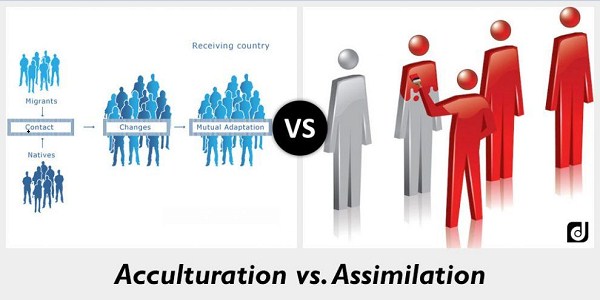Assimilation and acculturation are terms both of which intend to explain the effects of two cultures coming in contact with each other for long periods. They are very related terms and ideas. However, they are not the same. So, in this article, we will see what they are and how they differ from each other.

What are the definitions of assimilation and acculturation?
Definition of assimilation
In anthropology or sociology, assimilation is a process that involves individuals or groups which represent different ethnic lineages. Each group or individual comes from one or many of the dominant societal cultures. Therefore, this process involves tracing these dominantly cultural attributes. It does this to a level that makes each assimilating group socially inseparable from other groups existing in the society. Therefore, we can say that it is acculturation in its most extreme form.
Assimilation can occur both by wish or by binding force. However, we hardly find that a minority group can replace its original cultural practices in their entirety. Such practices include religion, food habits, cultural aesthetics as well as proxemics. An example of proxemics would be the distance the members choose to maintain between them under a particular social situation. So, these are the features that vehemently resist change of any kind. Racial or biological intermix can occur. However, the term “assimilation” does not mean it.
Definition of acculturation
Acculturation is a change that might be socio-political, cultural, or psychological. This change comes when two cultures try balancing against each other in the process of adapting to the dominant culture. So, this is a process whereby the individual adjusts, adopts, as well as acquires a new environment. This new environment, as a result, may occur due to two reasons. It might be due to the introduction of a new culture to an individual or when the individual opts for a new culture. When individuals of a different culture expose themselves to the dominant one, they try to emulate certain aspects of the dominant culture. Therefore, they try taking up food habits or aesthetics of that culture. However, they do not let their roots in their original cultural aesthetics and values go loose.
We can see the effects of acculturation at different levels of functioning. These include the ones who are assimilating into the new dominant culture and the ones who already belong to it. The effects are different at the individual level and group level.
At the group level, acculturation causes some major changes. These may include changes in various institutions like culture, religious practices, healthcare, and so on. As a result, we find that the newcomers who come into such an overarching culture show significant changes in food habits, dress sense, and even language.
At an individual level, acculturation works like a process of socialization that allows a foreign individual to mix into the dominant culture. So, to enable this process, the individual has to emulate values, rules, cultural attitudes and behaviors, and customs of the dominant culture. Therefore, such an emulation often leads to distinct changes in the psychological and physical health of the individual. The daily routine also significantly alters.
What are the examples of assimilation and acculturation?
Example of assimilation
Forced assimilation example
In the course of world history, there are innumerable examples of torture by authorities of first-world countries. They forcefully made minority groups assimilate into their cultures. Such examples of forced assimilation are the most prominent in the European imperialist colonies. These started in the eighteenth century. They continued through the nineteenth and twentieth centuries and exist even today. One finds various instances in what today is America, Latin America, Australia, Africa, and Asia. That is to tell everywhere out of the Euro-centric imagination.
Colonial politics compelled the tribes and indigenous people of these regions to undergo various transformations like-
- Religious conversion to Christianity.
- Robbing parents of their young ones and selling them off.
- Snatching the public property from them and putting them on sale.
- Destroying local sustainability, industry, and economy.
- Forcefully reversing gender roles between men and women. Imposing a heternormative way of living.
- Elimination of indigenous crops and shifting to cash crops beneficial to them.
- Cutting off their access to their original cultures, food, clothes, and customs.
Forced assimilation has always been horrific. It has created both immediate and far-fetched trauma. The perpetrator nations or powers could never cure these. Such a process has hardly been historically successful. Moreover, the negative consequences of this entire process cost the recipient culture heavily.
Voluntary assimilation example
Assimilation is generally a forceful movement that the perpetrator nation or dominant culture brings about. However, voluntary assimilation too finds mention in history. One such rare example dates back to the Spanish Inquisition. So, this is about geopolitics in the late 14th and 15th centuries. During this time, many Muslims and Jews converted themselves to Roman Catholicism by their free will. They did this to escape from execution on religious grounds. So, what we see is even voluntary assimilation comes indirectly due to pressure from the dominant culture. These converted Muslims called themselves Moriscos while the converted Jews called themselves Marranos.
However, it is interesting to note that they did practice their original religions in secrecy. This is because they did not want to convert themselves but did only to save themselves. So, they could never bring themselves to think of themselves as Catholics. So, what we can conclude is that assimilation is never successful. Whether the state sponsors it or the individual undertakes it voluntarily, it can never work out.
Example of acculturation
Acculturation might not be so forceful and cruel as assimilation. As we have already seen, assimilation occurs when acculturation has reached its farthest limits. So, acculturation happens when a non-dominant culture or culture takes up the customs or attitudes, or behaviors of the dominant culture over a period of time. This happens organically. The power that the dominant culture enjoys for ages is also responsible for it. Their routine settles on everyone else’s subconscious.
Read Also: Monomers: Types & Examples
For example, the traditional costume of Japan is Kimono and Obi. The traditional costume of the Indian subcontinent is mostly saree, kurta, etc. However, due to the western influence, exposure is very long. So, we find Japanese or Indian women wearing western clothes like skirts or shirts too. This has become their unconscious routine. This is how acculturation works.
What are the similarities between acculturation and assimilation?
Both Assimilation and acculturation operate on the minority culture adopting the majority culture. However, the way they operate is quite different. The circumstances that shape them are also not the same. We shall know about that in the next section.

What are the differences between acculturation and assimilation?
Assimilation is a broad concept. It enumerates the process by which members of the minority cultures take up new information regarding the majority cultures. This can be forceful, or voluntary but never without pressure. The state might sponsor this pressure or circumstances might develop so that the individual has to undertake it. It is generally immediate. However, the kind of trauma or reaction mechanism it generates is long-lasting and develops over history.
On the other hand, acculturation is not immediate. It does not include such direct, vehement exercise of pressure or power. However, in this case, the long-standing majority culture influences the subconscious of the minority members till they take up its aspects. However, this taking up is not all-encompassing or something that amounts to ethnic cleansing. Therefore, in this case, the minority culture exists in their regional barriers. However, they take up certain elements from the majority culture too over a period of time.




